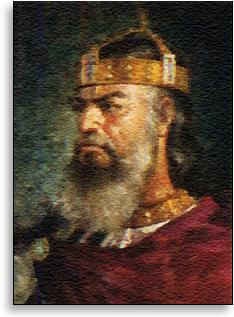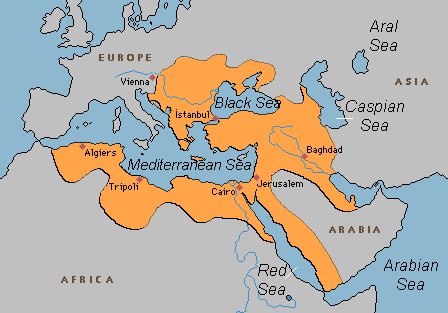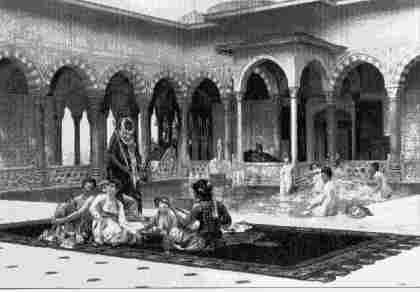 The
Muslim world continued to expand in the early modern era. A broad belt of
societies undergoing Islamization stretched across the Eastern Hemisphere. More
than seven centuries of Muslim rule in the Iberian Peninsula came to an end in
1492 with the completion of the Spanish Christian reconquest. Elsewhere,
however, new states and social institutions consolidated the gains of previous
centuries and initiated a new wave of growth. Eventually, interaction with the
rising states of Europe brought conflict on a global scale, with European
military victory but continued conversion of peoples and societies to Islam.
The
Muslim world continued to expand in the early modern era. A broad belt of
societies undergoing Islamization stretched across the Eastern Hemisphere. More
than seven centuries of Muslim rule in the Iberian Peninsula came to an end in
1492 with the completion of the Spanish Christian reconquest. Elsewhere,
however, new states and social institutions consolidated the gains of previous
centuries and initiated a new wave of growth. Eventually, interaction with the
rising states of Europe brought conflict on a global scale, with European
military victory but continued conversion of peoples and societies to Islam.
A number
of major Islamic states emerged during the sixteenth century. The largest was
the Ottoman Empire, which had been expanding from its original base as a Turkish
warrior state in western Anatolia. Ottoman forces conquered Constantinople in
1453 and Syria and Egypt in 1516-1517. Under the rule of Sultan Sulayman the
Magnificent, virtually all of the Balkan Peninsula became part of the empire in
the sixteenth century. In South Asia, Babur, a Central Asian military
adventurer, used gunpowder to defeat the Delhi Sultanate and establish the
foundations for the Mughal empire. By the end of the reign of Babur's grandson,
Akbar, in 1605, the Mughals ruled virtually all of India.
Small
military states in Iran were conquered by a new movement, the Safavids. Under
Ismail al-Safavi, who proclaimed himself Shah in 1501, the movement was
transformed from a Sufi-style organization to a dynastic state. Twelver Shi'ism
was proclaimed the official religion and, although most Iranians had been Sunni,
Shi'ism soon became the religion of the general population as well.
The
empires of Mali and Songhay in West Africa, the merchant city-states of East
Africa, the expansion of the Uzbek state under Shaybanid leadership, and the
sultanates of the peninsulas and islands of Southeast Asia all reflect the
political and social influence of Islamization by the sixteenth century.
By the
seventeenth century this picture started to change as empires began to weaken in
the face of war and internal strife. Ottoman expansion ceased in the seventeenth
century, and the empire lost wars and territories to expanding European states.
The Safavids' empire came to an end when Nadir, a military commander, assumed
the title of shah. Nadir Shah was militarily successful, but his state collapsed
after his death in 1747. The Mughals faced similar internal conflicts, revolts
by non-Muslims, and ultimately, conquest by the British. Elsewhere, smaller
Muslim states also suffered from civil wars and conquests by outside forces.
During
the next two centuries, most of the Muslim world came under direct or indirect
European control, and cultural life was increasingly shaped by European
influences, although there were important movements of Islamic renewal that also
had long-term significance.
 Ottoman
Empire, dynastic state centered in what is now Turkey, founded in the late 13th
century and dismantled in the early 20th century. At its height in the
mid-1500s, at the end of the reign of Süleyman I, the Ottoman Empire controlled
a vast area extending from the Balkan Peninsula to the Middle East and North
Africa. The empire went into slow decline after Süleyman.
Ottoman
Empire, dynastic state centered in what is now Turkey, founded in the late 13th
century and dismantled in the early 20th century. At its height in the
mid-1500s, at the end of the reign of Süleyman I, the Ottoman Empire controlled
a vast area extending from the Balkan Peninsula to the Middle East and North
Africa. The empire went into slow decline after Süleyman.
Before the rise of the Ottomans, the Byzantine Empire
controlled western Anatolia, while most of the rest of the region was controlled
by the Seljuk Turks. In the 13th century Seljuk power began to fade and a number
of small Turkish states began to emerge in the frontier lands between the
Byzantine Empire and the shrinking Seljuk state. In 1299 a Turkish Muslim
warrior known as Osman began to lead raids on Christian Byzantine settlements in
western Anatolia. The followers of Osman became known as Osmanlılar
(Turkish for "those associated with Osman"), or, the Ottomans. Beginning with
Osman, members of the House of Osman ruled the Ottoman state in unbroken
succession until 1922; these rulers were known as sultans.
Ottoman Expansion
Osman was able to bring other Turks under his banner
for two main reasons. First, the Ottomans had the most advantageous position of
all the Turkish states near the Byzantine frontier. They were centered at Söğüt
(near Eskişehir), which was close to the Nicaea (now İznik) area, which had been
the Greek Byzantine capital between 1204 and 1261. The Byzantines had settled
around Nicaea after being driven from their capital of Constantinople (now
İstanbul) by the Fourth Crusade in 1204. After recapturing Constantinople in
1261, the Byzantines sought to reassert their control over the Balkan Peninsula
and neglected the defenses of Nicaea and their other territories in Anatolia.
Their proximity to Nicaea offered the Ottomans the best opportunities for
plunder. Second, more than any other Turkish frontier state, they took the
concept of being a ghazi—that is, a warrior who carried out raids upon and
warfare with the Christians in the interests of Islam—and made it their guiding
principle.
 Under Osman, the Ottomans
besieged the main Byzantine strongholds between Söğüt and Nicaea. After Osman
died in 1326, his son and successor Orhan (reigned 1326-1362) took the city of
Bursa. From Bursa, which became the Ottoman capital, the Ottomans extended their
grip over the surrounding territory. Absorption of the Turkish frontier state of
Karası, extended Ottoman sway to the Sea of Marmara and the Aegean Sea.
Constantinople, the Byzantine capital and the goal of Islamic conquest since the
time of the Prophet Muhammad, was just across the Sea of Marmara.
Under Osman, the Ottomans
besieged the main Byzantine strongholds between Söğüt and Nicaea. After Osman
died in 1326, his son and successor Orhan (reigned 1326-1362) took the city of
Bursa. From Bursa, which became the Ottoman capital, the Ottomans extended their
grip over the surrounding territory. Absorption of the Turkish frontier state of
Karası, extended Ottoman sway to the Sea of Marmara and the Aegean Sea.
Constantinople, the Byzantine capital and the goal of Islamic conquest since the
time of the Prophet Muhammad, was just across the Sea of Marmara.
The Ottomans, however, were not yet strong enough to
launch a direct attack on the Byzantine Empire. Instead, they had themselves
hired as mercenaries to assist the Byzantine emperor against a rival claimant to
the throne. Attracted by the potential of plunder in Europe, they transformed
themselves from mercenaries into conquerors, capturing Gallipoli, on the
European side of the Dardanelles Strait, in 1354. The capture of Gallipoli
marked the beginning of Turkish presence in Europe.
Edirne, in Thrace, fell in 1361. After Orhan died in
1362, he was succeeded by Murad I (reigned 1362-1389), who directed the Ottoman
advance into the Balkan Peninsula. Needing a center closer to the expanding
frontier, Murad established Edirne as a second capital, a position it would hold
even after the Ottoman conquest of Constantinople in 1453.
Meanwhile, the Ottomans continued their expansion in
Anatolia at the expense of rival Turkish emirates (small states ruled by a
hereditary chief called an emir). The emirates bitterly criticized the Ottomans
for waging war on fellow Muslims rather than on Christians, but the Ottomans
continued to expand to the east.
Advancing into the Balkans, the Ottomans defeated the
Bulgarians and then marched into Serbia where, in June 1389, they defeated the
Serbs at the Battle of Kosovo. At the end of the battle, a Serb killed Murad,
and in retaliation the Ottomans executed Lazar, the Serbian prince.
Murad was succeeded by his son Bayazid I (reigned
1389-1402), who continued the Ottoman advance in both Europe and Anatolia.
Bayazid’s wheeling back and forth between the western and eastern fronts earned
him the nickname Yilderim (Turkish for "lightning" or "the thunderbolt"). In the
east, the Muslim Turkic conqueror Tamerlane emerged as a new threat. Supported
by the emirs dispossessed earlier by the Ottomans, Tamerlane defeated Bayazid
outside of Ankara in 1402. Perhaps to teach the Ottomans that true ghazis do not
war with other Muslims, Tamerlane restored former emirates and even gave
Bayazid’s sons their own territories.
Bayazid died in captivity, a suicide according to some
accounts, and a struggle for succession to the sultanate broke out among his
sons. Muhammad I (reigned 1413-1421) eventually won the title, having succeeded
in capturing the territories Tamerlane had given his brothers, and thereby
reunifying the Ottoman domains. After starting to recapture the emirates in
western Anatolia that had helped Tamerlane, Muhammad died in 1421 and was
succeeded by his son Murad II (reigned 1421-1444; 1446-1451).
By 1423 Murad II had repossessed western Anatolia.
Turning his attention to Europe, he annexed Serbia in 1439 and besieged
Hungarian-held Belgrade in 1440. Murad then grew weary of constant campaigning.
After arranging peace with Hungary and Serbia in 1444 and with his most powerful
enemy, the east central Anatolian emir of Karaman, he abdicated in favor of his
12-year-old son Muhammad II (reigned 1444-1446, 1451-1481). Reading this as a
sign of Ottoman weakness, Europe unleashed a new crusade to oust the Ottomans.
Murad came out of his retirement and roundly defeated the European army at Varna,
Bulgaria, in late 1444. Murad retired again in favor of Muhammad, but returned
in 1446 to put down a rebellion in Edirne. It was not until Murad’s death in
1451 that Muhammad II, later called Muhammad the Conqueror, returned to the
throne.
Each early Ottoman sultan launched his sultanate with a
great ghazi victory. For Muhammad, it was the conquest of Constantinople in
1453. After bombarding the city walls with cannon fire for months, Muhammad and
his troops succeeded in taking the city in less than a day and destroying the
last of the Byzantine Empire. Muhammad made Constantinople the new Ottoman
capital and created the imperial palace complex of Topkapı. He continued to
expand the Ottoman Empire into Europe, securing most of the Balkan Peninsula,
including Greece, Albania, Serbia, and Bosnia. Muhammad died in 1481 just as the
Ottoman armies were preparing a full-scale invasion of Italy, which was then
aborted.
The reign of Muhammad’s son and successor Bayazid II
(reigned 1481-1512) was weak in comparison. Two events occurred during his reign
that would challenge the Ottoman Empire for the next several centuries. The
first was the circumnavigation of Africa by Portuguese explorer Vasco da Gama
between 1497 and 1498. This voyage inaugurated a lucrative spice trade between
Europe and South Asia, and Portuguese fleets began to shut down Arab shipping
routes between India, southern Arabia, and Egypt that supplied the Ottoman spice
trade. The second was the rise of the Safavid dynasty in Iran in 1501. Unlike
the Ottomans, who were Sunni Muslims, the Safavids belonged to the Shiite branch
of Islam. As a nearby rival power with antagonistic Islamic beliefs, the
Safavids presented a challenge to the Islamic legitimacy of the Ottomans and
began to convert inhabitants of the eastern frontiers of the Ottoman Empire.
The Ottoman response to these challenges had to wait
for the reign of Selim I (reigned 1512-1520). Selim declared a holy war on the
Safavid dynasty, invading Safavid territory along the far eastern frontier and
defeating the Safavids in 1514 at Çaldıran. He then swept through Anatolia, down
the Fertile Crescent, and across the Red Sea to Egypt, capturing the two holiest
cities of Islam, Mecca and Medina, in the process. Seeking to expel the
Portuguese from the Indian Ocean, he created naval fleets at Suez, Egypt; though
the Portuguese were not expelled, Selim did manage to prevent the establishment
of a total Portuguese monopoly over the spice trade.
Selim I died in 1520 after having spent most of his
short reign on matters pertaining to the east. His son and successor Süleyman I
(reigned 1520-1566) again turned the attention of the Ottomans to the west. In
August 1521 Süleyman, later known as Süleyman the Magnificent, opened the road
to Hungary by capturing Belgrade, a Hungarian stronghold. He took the island of
Rhodes from the Knights of Saint John in December 1522, which signaled the
beginning of Ottoman domination of the eastern Mediterranean. In 1529 Süleyman
campaigned to the gates of the Habsburg city of Vienna in the west, and in 1534
took the Iranian city of Tabrīz in the east. When he died in 1566, while on
campaign in Hungary, Süleyman had become the preeminent Muslim ruler in the
world.
 Ottoman fortunes began
to decline after the death of Süleyman, but from such a great height that the
changes were imperceptible at first. While continuing to pressure the Habsburg
dynasty in Central Europe, the Ottomans maintained their naval presence in the
Mediterranean by taking Cyprus between 1570 and 1571. They protected their
eastern flank against the Safavids and even began to lock horns with a new
enemy, emerging Russia. Ottoman weakness began to show itself in the 17th
century against both the Habsburgs and Iran. The empire’s agricultural economy
was still strong and self-sufficient, however, giving the Ottomans great
recuperative powers which, when coupled with good leadership, could still make
them a world threat. Such was the case under Sultan Murad IV (reigned
1623-1640), who was the most vigorous sultan since Süleyman. He strengthened the
eastern Ottoman flank by capturing Baghdād from the Safavids. After his death
the empire experienced severe internal crises, including disorder in the
provinces, unrest in the military as serious inflation caused soldiers to be
underpaid or not paid at all, and succession issues due to the lack of
candidates who were of age to assume the sultanate. This led to a period in
Ottoman history known as "the Sultanate of the Women." During this period the
political impact of the harem was felt and the mothers of young sultans
exercised power in the name of their sons.
Ottoman fortunes began
to decline after the death of Süleyman, but from such a great height that the
changes were imperceptible at first. While continuing to pressure the Habsburg
dynasty in Central Europe, the Ottomans maintained their naval presence in the
Mediterranean by taking Cyprus between 1570 and 1571. They protected their
eastern flank against the Safavids and even began to lock horns with a new
enemy, emerging Russia. Ottoman weakness began to show itself in the 17th
century against both the Habsburgs and Iran. The empire’s agricultural economy
was still strong and self-sufficient, however, giving the Ottomans great
recuperative powers which, when coupled with good leadership, could still make
them a world threat. Such was the case under Sultan Murad IV (reigned
1623-1640), who was the most vigorous sultan since Süleyman. He strengthened the
eastern Ottoman flank by capturing Baghdād from the Safavids. After his death
the empire experienced severe internal crises, including disorder in the
provinces, unrest in the military as serious inflation caused soldiers to be
underpaid or not paid at all, and succession issues due to the lack of
candidates who were of age to assume the sultanate. This led to a period in
Ottoman history known as "the Sultanate of the Women." During this period the
political impact of the harem was felt and the mothers of young sultans
exercised power in the name of their sons.
Political order was restored in 1656 when Turhan, the
mother of Sultan Muhammad IV, allowed an aged but astute military figure,
Köprülü Muhammad Pasha, to assume the office of grand vizier (chief minister).
In his brief five years of office, Köprülü got rid of incompetent officials,
ferreted out corruption, and revived the vigor and pride of the Ottoman Empire.
He also quelled several rebellions, strengthened the empire’s defenses, and led
the Ottoman forces to victories against the Venetian navy. Upon his death in
1661 he was succeeded as grand vizier by his own son, Köprülü Fazıl Ahmed Pasha,
thus creating the first family dynasty within the grand vizierate.
Köprülü Fazıl Ahmed was a great campaigner. Under him
the Ottomans captured much of Ukraine from Poland, and in 1669 completed the
conquest of Crete (Kríti), the last great Ottoman acquisition. He died in 1676
after igniting fear in Europe of the reinvigorated Ottoman Empire. His
successor, Kara Mustafa Pasha, worried Europe further when the Ottoman army in
1683 appeared for the second time before the gates of Vienna. Due to Kara
Mustafa’s poor strategy, however, the Ottoman army was routed by reinforcing
Polish armies. The failure cost Kara Mustafa his life, as he was executed by
Muhammad IV’s order during the Ottoman retreat. Without the steadying hand of
the Köprülüs, the Ottomans fell back into their earlier state of corruption and
internal dissent. Military losses mounted. In 1697 a new Austrian commander,
Prince Eugene of Savoy, ambushed the Ottoman army at Senta in northern Serbia,
inflicting great losses. The Treaty of Karlowitz restored peace in January 1699.
Under the treaty the Ottoman Empire was, for the first time, forced to
relinquish territory it had long held under its control. This event marked the
beginning of the Ottoman retreat from the Balkan Peninsula.
 The
Muslim world continued to expand in the early modern era. A broad belt of
societies undergoing Islamization stretched across the Eastern Hemisphere. More
than seven centuries of Muslim rule in the Iberian Peninsula came to an end in
1492 with the completion of the Spanish Christian reconquest. Elsewhere,
however, new states and social institutions consolidated the gains of previous
centuries and initiated a new wave of growth. Eventually, interaction with the
rising states of Europe brought conflict on a global scale, with European
military victory but continued conversion of peoples and societies to Islam.
The
Muslim world continued to expand in the early modern era. A broad belt of
societies undergoing Islamization stretched across the Eastern Hemisphere. More
than seven centuries of Muslim rule in the Iberian Peninsula came to an end in
1492 with the completion of the Spanish Christian reconquest. Elsewhere,
however, new states and social institutions consolidated the gains of previous
centuries and initiated a new wave of growth. Eventually, interaction with the
rising states of Europe brought conflict on a global scale, with European
military victory but continued conversion of peoples and societies to Islam. Ottoman
Empire, dynastic state centered in what is now Turkey, founded in the late 13th
century and dismantled in the early 20th century. At its height in the
mid-1500s, at the end of the reign of Süleyman I, the Ottoman Empire controlled
a vast area extending from the Balkan Peninsula to the Middle East and North
Africa. The empire went into slow decline after Süleyman.
Ottoman
Empire, dynastic state centered in what is now Turkey, founded in the late 13th
century and dismantled in the early 20th century. At its height in the
mid-1500s, at the end of the reign of Süleyman I, the Ottoman Empire controlled
a vast area extending from the Balkan Peninsula to the Middle East and North
Africa. The empire went into slow decline after Süleyman. Under Osman, the Ottomans
besieged the main Byzantine strongholds between Söğüt and Nicaea. After Osman
died in 1326, his son and successor Orhan (reigned 1326-1362) took the city of
Bursa. From Bursa, which became the Ottoman capital, the Ottomans extended their
grip over the surrounding territory. Absorption of the Turkish frontier state of
Karası, extended Ottoman sway to the Sea of Marmara and the Aegean Sea.
Constantinople, the Byzantine capital and the goal of Islamic conquest since the
time of the Prophet Muhammad, was just across the Sea of Marmara.
Under Osman, the Ottomans
besieged the main Byzantine strongholds between Söğüt and Nicaea. After Osman
died in 1326, his son and successor Orhan (reigned 1326-1362) took the city of
Bursa. From Bursa, which became the Ottoman capital, the Ottomans extended their
grip over the surrounding territory. Absorption of the Turkish frontier state of
Karası, extended Ottoman sway to the Sea of Marmara and the Aegean Sea.
Constantinople, the Byzantine capital and the goal of Islamic conquest since the
time of the Prophet Muhammad, was just across the Sea of Marmara. Ottoman fortunes began
to decline after the death of Süleyman, but from such a great height that the
changes were imperceptible at first. While continuing to pressure the Habsburg
dynasty in Central Europe, the Ottomans maintained their naval presence in the
Mediterranean by taking Cyprus between 1570 and 1571. They protected their
eastern flank against the Safavids and even began to lock horns with a new
enemy, emerging Russia. Ottoman weakness began to show itself in the 17th
century against both the Habsburgs and Iran. The empire’s agricultural economy
was still strong and self-sufficient, however, giving the Ottomans great
recuperative powers which, when coupled with good leadership, could still make
them a world threat. Such was the case under Sultan Murad IV (reigned
1623-1640), who was the most vigorous sultan since Süleyman. He strengthened the
eastern Ottoman flank by capturing Baghdād from the Safavids. After his death
the empire experienced severe internal crises, including disorder in the
provinces, unrest in the military as serious inflation caused soldiers to be
underpaid or not paid at all, and succession issues due to the lack of
candidates who were of age to assume the sultanate. This led to a period in
Ottoman history known as "the Sultanate of the Women." During this period the
political impact of the harem was felt and the mothers of young sultans
exercised power in the name of their sons.
Ottoman fortunes began
to decline after the death of Süleyman, but from such a great height that the
changes were imperceptible at first. While continuing to pressure the Habsburg
dynasty in Central Europe, the Ottomans maintained their naval presence in the
Mediterranean by taking Cyprus between 1570 and 1571. They protected their
eastern flank against the Safavids and even began to lock horns with a new
enemy, emerging Russia. Ottoman weakness began to show itself in the 17th
century against both the Habsburgs and Iran. The empire’s agricultural economy
was still strong and self-sufficient, however, giving the Ottomans great
recuperative powers which, when coupled with good leadership, could still make
them a world threat. Such was the case under Sultan Murad IV (reigned
1623-1640), who was the most vigorous sultan since Süleyman. He strengthened the
eastern Ottoman flank by capturing Baghdād from the Safavids. After his death
the empire experienced severe internal crises, including disorder in the
provinces, unrest in the military as serious inflation caused soldiers to be
underpaid or not paid at all, and succession issues due to the lack of
candidates who were of age to assume the sultanate. This led to a period in
Ottoman history known as "the Sultanate of the Women." During this period the
political impact of the harem was felt and the mothers of young sultans
exercised power in the name of their sons.